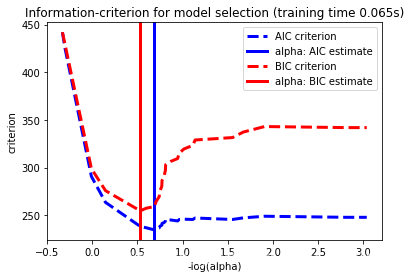sklearn 套索回归模型和参数选择
2019-07-09 17:48
681 查看
本算例主要验证套索回归中,分别采用AIC,BIC和交叉验证动态调整alpha的值,对结果的影响。
采用AIC、BIC信息标准的模型选择通常十分迅速,但是依赖于对合适的自由度的评价,并且在大数据量的分析中,往往假定模型是正确的,然而基于数据产生的模型去描述事物通常不准确,存在实际特征大于样本的情况。
对于交叉验证,分别采用20层的LassoCV算法和最小角回归算法路径进行计算,又称为并行下降算法,这2种算法得出结果大致相同,不同的是计算速度和数据误差的来源。
最小角回归算法,从结果上来说,在数据特征维度不大时,非常有效,而且计算不需要设定任何初始值。相对来看,并行下降算法(即交叉验证),在一个特定的网络结构中计算(算例中使用的初始值),因此在计算节点数小于特征维度时,效率会很高。因此,在特征维度很大,且数据样本充足的条件下,交叉验证的方法相对于单纯的最小角回归算法,训练误差会更小。
值得注意的是,在针对不确定或不可观测的数据时,模型的选择和参数的设置息息相关。
print(__doc__)
# Author: Olivier Grisel, Gael Varoquaux, Alexandre Gramfort
# License: BSD 3 clause
import time
import numpy as np
import matplotlib.pyplot as plt
from sklearn.linear_model import LassoCV, LassoLarsCV, LassoLarsIC
from sklearn import datasets
diabetes = datasets.load_diabetes()
X = diabetes.data
y = diabetes.target
rng = np.random.RandomState(42)
X = np.c_[X, rng.randn(X.shape[0], 14)] # add some bad features
# normalize data as done by Lars to allow for comparison
X /= np.sqrt(np.sum(X ** 2, axis=0))
# #############################################################################
# LassoLarsIC: least angle regression with BIC/AIC criterion
model_bic = LassoLarsIC(criterion='bic')
t1 = time.time() #计时
model_bic.fit(X, y)
t_bic = time.time() - t1
alpha_bic_ = model_bic.alpha_
model_aic = LassoLarsIC(criterion='aic')
model_aic.fit(X, y)
alpha_aic_ = model_aic.alpha_
def plot_ic_criterion(model, name, color):
alpha_ = model.alpha_
alphas_ = model.alphas_
criterion_ = model.criterion_
plt.plot(-np.log10(alphas_), criterion_, '--', color=color,
linewidth=3, label='%s criterion' % name)
plt.axvline(-np.log10(alpha_), color=color, linewidth=3,
label='alpha: %s estimate' % name)
plt.xlabel('-log(alpha)')
plt.ylabel('criterion')
plt.figure()
plot_ic_criterion(model_aic, 'AIC', 'b')
plot_ic_criterion(model_bic, 'BIC', 'r')
plt.legend()
plt.title('Information-criterion for model selection (training time %.3fs)'
% t_bic)
# #############################################################################
# LassoCV: coordinate descent
# Compute paths
print("Computing regularization path using the coordinate descent lasso...")
t1 = time.time()
model = LassoCV(cv=20).fit(X, y)
t_lasso_cv = time.time() - t1
# Display results
m_log_alphas = -np.log10(model.alphas_)
plt.figure()
ymin, ymax = 2300, 3800
plt.plot(m_log_alphas, model.mse_path_, ':')
plt.plot(m_log_alphas, model.mse_path_.mean(axis=-1), 'k',
label='Average across the folds', linewidth=2)
plt.axvline(-np.log10(model.alpha_), linestyle='--', color='k',
label='alpha: CV estimate')
plt.legend()
plt.xlabel('-log(alpha)')
plt.ylabel('Mean square error')
plt.title('Mean square error on each fold: coordinate descent '
'(train time: %.2fs)' % t_lasso_cv)
plt.axis('tight')
plt.ylim(ymin, ymax)
# #############################################################################
# LassoLarsCV: least angle regression
# Compute paths
print("Computing regularization path using the Lars lasso...")
t1 = time.time()
model = LassoLarsCV(cv=20).fit(X, y)
t_lasso_lars_cv = time.time() - t1
# Display results
m_log_alphas = -np.log10(model.cv_alphas_)
plt.figure()
plt.plot(m_log_alphas, model.mse_path_, ':')
plt.plot(m_log_alphas, model.mse_path_.mean(axis=-1), 'k',
label='Average across the folds', linewidth=2)
plt.axvline(-np.log10(model.alpha_), linestyle='--', color='k',
label='alpha CV')
plt.legend()
plt.xlabel('-log(alpha)')
plt.ylabel('Mean square error')
plt.title('Mean square error on each fold: Lars (train time: %.2fs)'
% t_lasso_lars_cv)
plt.axis('tight')
plt.ylim(ymin, ymax)
plt.show()



相关文章推荐
- 最小角回归 LARS算法包的用法以及模型参数的选择(R语言 )
- sklearn模型调优(判断是否过过拟合及选择参数)
- python机器学习库sklearn——数据归一化、标准化、特征选择、逻辑回归、贝叶斯分类器、KNN模型、支持向量机、参数优化
- 【scikit-learn】交叉验证及其用于参数选择、模型选择、特征选择的例子
- 【Scikit-Learn 中文文档】优化估计器的超参数 - 模型选择和评估 - 用户指南 | ApacheCN
- sklearn 源码解析 基本线性模型 岭回归 ridge.py(2)
- python机器学习模型选择&调参工具Hyperopt-sklearn(1)——综述&分类问题
- 【Scikit-Learn 中文文档】优化估计器的超参数 - 模型选择和评估 - 用户指南 | ApacheCN
- 【Scikit-Learn 中文文档】优化估计器的超参数 - 模型选择和评估 - 用户指南 | ApacheCN
- 【Scikit-Learn 中文文档】29 优化估计器的超参数 - 模型选择和评估 - 用户指南 | ApacheCN
- cross_val_score交叉验证及其用于参数选择、模型选择、特征选择
- 【Scikit-Learn 中文文档】优化估计器的超参数 - 模型选择和评估 - 用户指南 | ApacheCN
- 逻辑回归模型(二)——sklearn实现逻辑回归(logistic regression)
- 【Scikit-Learn 中文文档】46 模型选择:选择估计量及其参数 - 关于科学数据处理的统计学习教程 - scikit-learn 教程 | ApacheCN
- 【scikit-learn】交叉验证及其用于参数选择、模型选择、特征选择的例子
- 【Scikit-Learn 中文文档】优化估计器的超参数 - 模型选择和评估 - 用户指南 | ApacheCN
- sklearn特征选择和分类模型
- 逻辑回归模型(二)——sklearn实现逻辑回归(logistic regression)
- 【Scikit-Learn 中文文档】模型选择:选择估计量及其参数 - 关于科学数据处理的统计学习教程 - scikit-learn 教程 | ApacheCN
- 【Scikit-Learn 中文文档】模型选择:选择估计量及其参数 - 关于科学数据处理的统计学习教程 - scikit-learn 教程 | ApacheCN
